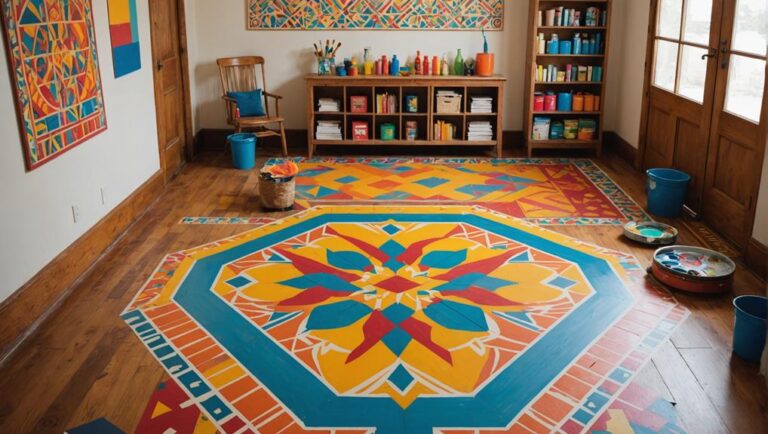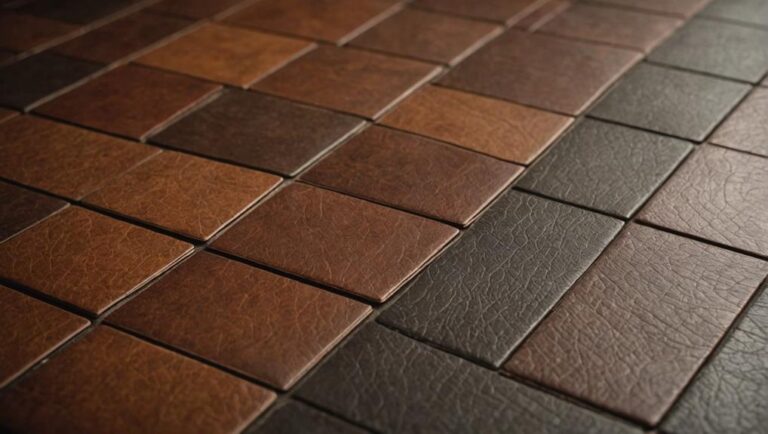Repairing damaged parquet flooring starts with a detailed assessment to identify scratches, gaps, and water damage. You'll need essential tools like an orbital sander, wood adhesives, and a putty knife. Prepare the area by cleaning and ensuring it's free of debris. For minor scratches, fill and polish the surface; for water damage, dry the area and decide whether to sand or replace severely damaged boards. When replacing tiles, measure and fit new pieces carefully, securing them with adhesive. Finally, refinishing restores the floor's appearance. For more advanced techniques and tips, you can uncover deeper insights that could enhance your project.
Identifying the Damage
When inspecting your parquet flooring for damage, it is vital to take a systematic approach. Begin by checking the entire surface for visible signs of wear, such as scratches, dents, or discoloration. Pay close attention to high-traffic areas, as these are more prone to damage. You'll want to kneel down and examine the boards closely. Look for any gaps between the planks; this can indicate water damage or improper installation.
Next, perform a damage assessment by testing the integrity of the individual tiles. Gently press down on each tile to see if any feel loose or unstable. If you notice any movement, it's important to identify whether the issue is due to humidity, moisture, or structural problems. Check for mold or mildew, as these can compromise the flooring's condition and lead to further damage.
Once you've identified the extent of the damage, consider your repair options. Minor scratches can often be buffed out with wood polish, while deeper dents may require wood filler or sanding. For loose tiles, you might need to re-glue or replace them entirely. If there's extensive water damage, it may necessitate professional help to guarantee a thorough and safe repair.
Tools You'll Need
To effectively repair damaged parquet flooring, you'll need a selection of essential tools that will aid in both minor and major repairs. Each tool plays a critical role in guaranteeing your repairs are safe, efficient, and yield professional results. Here's a concise list of tools you should gather before starting your project:
| Tool | Purpose |
|---|---|
| Orbital Sander | For applying sanding techniques to smooth surfaces before repairs. |
| Wood Adhesives | To bond any loose or damaged parquet pieces securely. |
| Putty Knife | For spreading wood fillers or adhesives evenly. |
| Floor Scraper | To remove any old adhesive or debris from the flooring. |
| Measuring Tape | To accurately measure areas before cutting or fitting new pieces. |
Using an orbital sander will allow you to employ the right sanding techniques, guaranteeing a level surface for your repairs. When selecting wood adhesives, make sure they're suitable for parquet flooring to assure a strong bond and prevent future damage. A putty knife will help you apply fillers smoothly, while a floor scraper guarantees the area is clean and prepped for repair. Finally, a measuring tape is essential for precision, preventing miscuts and ensuring pieces fit perfectly in place.
Preparing the Area
Before diving into the actual repair work, it's crucial to prepare the area properly. Start by clearing the space where you'll be working. Remove all furniture and items from the floor, as this will not only give you ample room to maneuver but also prevent any accidental damage to your belongings. When it comes to furniture placement, consider stacking lighter items in a safe corner and using protective pads underneath heavier pieces if you need to move them temporarily.
Next, you'll want to clean the parquet floor thoroughly. Use cleaning tips that suit your flooring type, focusing on removing dust, debris, and any sticky residues. A vacuum with a soft brush attachment is ideal for getting rid of dirt without scratching the surface. After vacuuming, dampen a microfiber mop with a suitable wood cleaner to wipe down the area. Make sure that the mop isn't too wet, as excess moisture can lead to further damage.
Once the floor is clean, inspect it closely for any areas that may require extra attention before starting repairs. Look for loose boards, cracks, or gaps that might need to be addressed. If you've identified any, make a note of them, as this will help streamline your repair process. Finally, verify that the area is well-lit and free from hazards, such as loose cords or obstacles, to promote a safe working environment. By taking these preparatory steps, you'll set yourself up for a smoother and safer repair experience.
Repairing Minor Scratches
To effectively repair minor scratches in your parquet flooring, you'll first need to assess the severity of each scratch. Once you've identified whether it's just a surface blemish or deeper damage, you can choose appropriate DIY repair techniques. Simple methods like using a wood filler or a touch-up pen can restore the floor's appearance without extensive intervention.
Identify Scratch Severity
Evaluating scratch severity is vital for determining the appropriate repair method for your parquet flooring. Scratches can vary markedly in depth and appearance, and understanding scratch types is key to effective repairs. Common scratch types include surface scratches, which only affect the finish, and deeper scratches that penetrate the wood veneer.
To identify severity indicators, inspect the scratches closely. Light scratches are often barely visible and can be felt with a fingernail but don't catch it. Moderate scratches are more noticeable, with clear lines that may disrupt the wood grain. If you can feel a scratch with your fingernail and it's visible, it likely falls into this category. Severe scratches, on the other hand, will not only be visible but may expose the underlying layers of wood, requiring more extensive repair work.
It's essential to assess the extent of the damage before proceeding with repairs. This guarantees that you select the right products and techniques that won't compromise your flooring's integrity. By accurately identifying the severity of the scratches, you can maintain the beauty and safety of your parquet flooring while effectively addressing any imperfections.
DIY Repair Techniques
Once you've assessed the scratch severity on your parquet flooring, you can move on to repairing minor scratches effectively. For this DIY repair, you'll want to use eco-friendly materials that guarantee both safety and sustainability during the parquet restoration process.
Here's a quick guide to help you with the repair:
| Step | Materials Needed |
|---|---|
| Clean the area | Microfiber cloth, gentle cleaner |
| Fill the scratch | Wood filler or wax stick |
| Sand the area | Fine grit sandpaper |
| Finish the repair | Eco-friendly wood polish |
Start by cleaning the scratched area thoroughly to remove any dirt or debris. Next, use a wood filler or wax stick that matches your parquet's color to fill in the scratch. Once it's dried, gently sand the area with fine grit sandpaper to guarantee a smooth finish. Finally, apply an eco-friendly wood polish to restore the shine and protect the surface.
Fixing Water Damage
Water damage can wreak havoc on parquet flooring, leading to warped boards and unsightly stains. If you've faced such issues, addressing the damage promptly is essential to prevent further deterioration. Here's a structured approach to fixing water damage effectively:
- Assess the Damage: Start by identifying the extent of the water damage. Look for warping, discoloration, and any signs of mold or mildew. This will help you determine whether you can perform water stain removal or if more extensive repairs are necessary.
- Dry the Area: Before any repairs, make sure the affected area is completely dry. Use fans and dehumidifiers to eliminate moisture. Installing a moisture barrier can help prevent future water exposure and protect your flooring.
- Repair or Replace: If the boards are slightly warped, you may be able to sand them down and refinish the surface. For deeper damage, you might need to replace individual tiles. Make sure to match the new tiles with your existing flooring for a seamless look.
Replacing Damaged Tiles
After addressing water damage, you may still find that certain tiles in your parquet flooring are beyond repair. In such cases, replacing damaged tiles becomes necessary to maintain the integrity and appearance of your flooring. First, identify the type of parquet tiles you have, as there are various parquet tile types, including solid hardwood, engineered wood, and laminate. Knowing the specific type will guide your replacement process.
To begin, remove the damaged tile carefully. Use a chisel or utility knife to cut through any adhesive and gently pry the tile up, making sure you don't damage the surrounding tiles. Once removed, clean the area thoroughly to prepare for the new tile.
Next, select a replacement tile that matches your existing flooring in both color and thickness. If you can't find an exact match, consider purchasing a small sample to ascertain compatibility. Depending on the parquet tile type, you'll need to choose the appropriate installation method. For solid hardwood and engineered wood, a glue-down or nail-down method is common, while laminate tiles often use a click-lock system.
Once you've chosen your tile and installation method, apply adhesive if necessary and securely place the new tile in the designated area. Use a roller or heavy object to guarantee proper adhesion. Finally, allow the adhesive to cure according to the manufacturer's instructions before walking on the new tile. This careful process helps maintain the safety and aesthetic quality of your parquet flooring.
Refinishing the Flooring
To refinish your parquet flooring effectively, you'll first need to prepare the surface by cleaning and sanding it to remove any imperfections. Next, choosing the right finish—whether it's oil-based, water-based, or a polyurethane option—is essential for achieving the desired look and durability. Finally, mastering application techniques will guarantee a smooth and even coat, enhancing the floor's overall appearance and longevity.
Preparing the Surface
Starting with a clean and smooth surface is essential for effectively refinishing parquet flooring. Before diving into the refinishing process, you need to guarantee that the surface is properly prepared. This not only enhances the final result but also guarantees safety during the refinishing.
Here are three key steps to prepare your parquet flooring:
- Surface Cleaning: Begin by sweeping and vacuuming the area to remove dust and debris. Follow this by mopping with a gentle cleaner to eliminate any grime or residue. Allow the floor to dry completely.
- Sanding Techniques: Use appropriate sanding techniques to remove any old finish. Choose a drum sander for larger areas and an orbital sander for corners and edges. Always wear a dust mask and goggles to protect yourself from dust and particles.
- Inspect for Damage: After sanding, examine the floor for any imperfections. Fill in gaps or holes with wood filler and guarantee the surface is level before proceeding.
Choosing the Finish
When it comes to refinishing parquet flooring, choosing the right finish is crucial for achieving both aesthetic appeal and long-lasting protection. You'll typically encounter two main types of finishes: oil finishes and water-based finishes. Oil finishes penetrate the wood, enhancing natural grain and providing a warm appearance, while water-based finishes offer a quicker drying time and lower odor, making them a safer choice for indoor environments.
When deciding between matte and glossy finishes, consider the look you want to achieve. Matte finishes create a more subtle, modern appearance, while glossy finishes add depth and shine, highlighting the wood's texture. If you're environmentally conscious, explore eco-friendly options that reduce VOC emissions, guaranteeing a healthier indoor air quality.
Color matching is critical, particularly if you're only refinishing certain sections of your parquet. Make sure to conduct a durability comparison between finishes to assess how well they'll withstand wear and tear. Finally, familiarize yourself with the various application methods, as they can greatly impact the finished product. Choose wisely to confirm your parquet flooring not only looks beautiful but stands the test of time.
Application Techniques
Selecting the right finish sets the stage for the refinishing process, but applying that finish correctly is what truly brings your parquet flooring back to life. Proper application techniques are essential for achieving a durable and aesthetically pleasing result. Here are some application tips to guarantee your project goes smoothly:
- Prep the Surface: Thoroughly clean the floor and repair any damaged areas using appropriate repair methods. Remove dust and debris to create a smooth surface for the finish.
- Use the Right Tools: Invest in high-quality brushes or rollers suitable for your chosen finish. A good applicator will help you achieve an even coat without leaving streaks or bubbles.
- Apply in Sections: Work in manageable sections to maintain a wet edge, preventing lap marks. Start at one corner and move systematically across the room, applying thin coats for better adhesion and drying.
Always follow the manufacturer's instructions for drying times and re-coat intervals. By adhering to these application techniques, you'll guarantee your parquet flooring not only looks beautiful but also stands the test of time. Safety first—make sure to ventilate the area and wear protective gear during the process.
Maintaining Parquet Floors
Proper maintenance of parquet floors is vital to preserve their beauty and longevity. To guarantee your floors stay in top condition, it's important to adopt effective cleaning techniques and protective measures. Regular cleaning is the first step; use a soft-bristle broom or a microfiber dust mop to remove dust and debris. Avoid using excessive water, as moisture can seep into the seams and cause damage. Instead, lightly dampen your mop with a hardwood-safe cleaner.
When it comes to deeper cleaning, choose products specifically designed for parquet floors. Look for pH-balanced cleaners to prevent dulling the finish. Always follow the manufacturer's instructions regarding dilution and usage to avoid any adverse effects.
Protective measures are equally important. Place mats at entryways to trap dirt and moisture before it reaches your floors. Use felt pads under furniture legs to prevent scratches and dents. If you have pets, keep their nails trimmed to minimize potential damage.
Additionally, consider using area rugs in high-traffic zones. These can provide an extra layer of protection against wear and tear. For ongoing maintenance, schedule periodic refinishing to restore the floor's shine and reinforce its protective layer.
Frequently Asked Questions
How Can I Prevent Future Damage to My Parquet Flooring?
To prevent future damage to your parquet flooring, adopt proper cleaning techniques like using a soft broom or a damp mop to avoid excess moisture. Be cautious with harsh chemicals that can erode the finish. Additionally, maintain humidity control in your home, ideally between 30-50%. This helps prevent warping and cracking. Regularly inspect for signs of damage, ensuring timely intervention to safeguard your flooring's integrity and longevity.
Is It Worth Hiring a Professional for Parquet Repairs?
Did you know that 70% of DIY flooring repairs end up costing more than hiring a professional? When considering parquet repairs, a thorough cost analysis can reveal that your time and potential mistakes might outweigh the DIY options. Professionals not only guarantee safety but also have the right tools and expertise to restore your flooring effectively. If you want a long-lasting solution, investing in a professional could save you money and headaches in the long run.
Can I Use Area Rugs to Protect My Parquet Floors?
Yes, you can definitely use area rugs to protect your parquet floors. Area rugs provide a range of benefits, including reducing wear and tear, minimizing scratches, and absorbing impact from foot traffic. Regular use of area rugs can considerably enhance your flooring maintenance routine, ensuring your parquet remains in excellent condition. Just make sure to choose rugs with non-slip backing to maintain safety and prevent any accidents while walking on them.
What Types of Finishes Are Best for Parquet Flooring?
When it comes to finishes for parquet flooring, you'll find that around 70% of homeowners prefer water-based finishes due to their quick drying time and low VOC emissions. Oil finishes, while offering a rich, deep color, can take longer to cure and may emit stronger odors. If safety's a priority for you, water-based options are generally considered safer for indoor air quality, making them a popular choice among health-conscious consumers.
How Often Should I Refinish My Parquet Floors?
You should consider refinishing your parquet floors every 5 to 10 years, depending on foot traffic and wear. For ideal maintenance, regularly clean them and apply protective coatings to extend the finish's life. This refinishing frequency guarantees your floors remain safe and visually appealing. Remember to use low-VOC products to maintain indoor air quality. Following these maintenance tips preserves your floor's integrity and reduces the need for frequent, extensive repairs.




